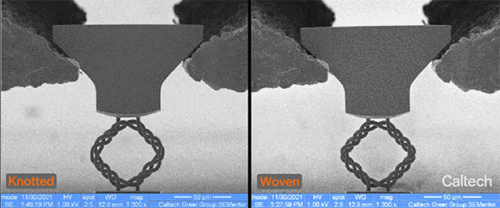Caltech engineers have created a brand new materials made from extremely interconnected microscale knots within the newest development in nano- and micro-architected supplies.

The tensile energy of a fabric constructed with microscale knots (left), in comparison with that of a fabric that lacks knots however is in any other case structurally equivalent (proper). Picture Credit score: The California Institute of Know-how.
The knots make the fabric far harder than identically structured however unknotted supplies, they take up extra vitality, and so they can deform extra whereas returning to their authentic form undamaged. Due to their sturdiness, potential biocompatibility, and extreme deformability, these new knotted supplies might discover vast functions in biomedicine and aerospace sectors.
The potential to beat the final trade-off between materials deformability and tensile toughness [the ability to be stretched without breaking] affords new methods to design gadgets which are extraordinarily versatile, sturdy, and may function in excessive situations.
Widianto P. Moestopo, Examine Lead Writer, Lawrence Livermore Nationwide Laboratory
Widianto P. Moestopo is a former Caltech graduate scholar Widianto P. Moestopo (MS ‘19, PhD ‘22. The research was revealed on March 8th, 2023, within the journal Science Advances.
Moestopo labored in Julia R. Greer’s lab, the Ruben F. and Donna Mettler Professor of Supplies Science, Mechanics, and Medical Engineering, and the Fletcher Jones Basis. Julia R. Greer can be the Director of the Kavli Nanoscience Institute and a senior writer of the Science Advances paper.
Greer is a pioneer within the growth of nano-architected supplies, or supplies whose construction is designed and arranged on the nanometer scale and thus exhibit uncommon, typically shocking properties.
Embarking on understanding how the knots would have an effect on the mechanical response of micro-architected supplies was a brand new out-of-the-box concept. We had accomplished in depth analysis on finding out the mechanical deformation of many different sorts of micro-textiles, for instance, lattices and woven supplies. Venturing into the world of knots allowed us to realize deeper insights into the function of friction and vitality dissipation and proved to be significant.
Julia R. Greer, Director, Kavli Nanoscience Institute
Every knot measures roughly 70 µm in peak and width, and every fiber has a radius of roughly 1.7 µm (round one-hundredth the radius of a human hair). Whereas these should not the smallest knots ever made (in 2017, chemists tied a knot comprised of a single strand of atoms), they’re the primary time a fabric made up of quite a few knots at this scale has been created.
Moreover, it demonstrates the potential utility of incorporating these nanoscale knots into a fabric, equivalent to suturing or tethering in biomedicine.
The knotted polymer supplies have tensile toughness that far outperforms unknotted however in any other case equally structured supplies, together with these during which particular person strands are interwoven relatively than knotted. In distinction to unknotted supplies, knotted supplies take up 92% extra vitality and want greater than twice the pressure to snap when pulled.
The knots have been produced in a knotted state relatively than tied, using superior high-resolution 3D lithography able to producing constructions on the nanoscale. The samples described within the Science Advances paper have easy knots—an overhand knot with an additional twist that provides friction to soak up extra vitality as the fabric is stretched. The group intends to analyze supplies comprised of extra advanced knots sooner or later.
Moestopo’s fascination with knots stemmed from analysis he was pursuing in 2020 in the course of the COVID-19 lockdowns.
I got here throughout some works from researchers who’re finding out the mechanics of bodily knots versus knots in a purely mathematical sense. I don’t take into account myself a climber, a sailor, or a mathematician, however I’ve tied knots all through my life, so I believed it was price attempting to insert knots into my designs.
Widianto P. Moestopo, Examine Lead Writer, Lawrence Livermore Nationwide Laboratory
The co-authors of the research are Caltech graduate college students Sammy Shaker and Weiting Deng. The research was supported by the Nationwide Science Basis by means of Moestopo’s Graduate Analysis Fellowship Program, Caltech’s Clinard Innovation Fund, Greer’s Vannevar Bush College Fellowship, and the Workplace of Naval Analysis.
Journal Reference
Moestopo, W. P., et al. (2023) Knots should not for naught: Design, properties, and topology of hierarchical intertwined microarchitected supplies. Science Advances. doi.org/10.1126/sciadv.ade6725.
Supply: https://www.caltech.edu
